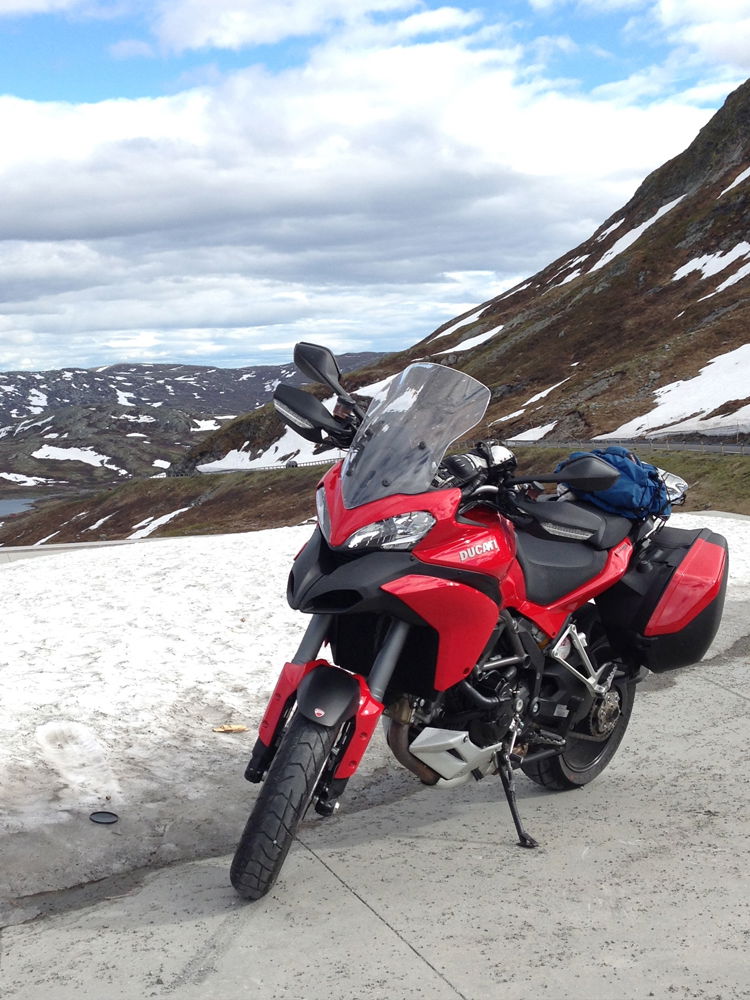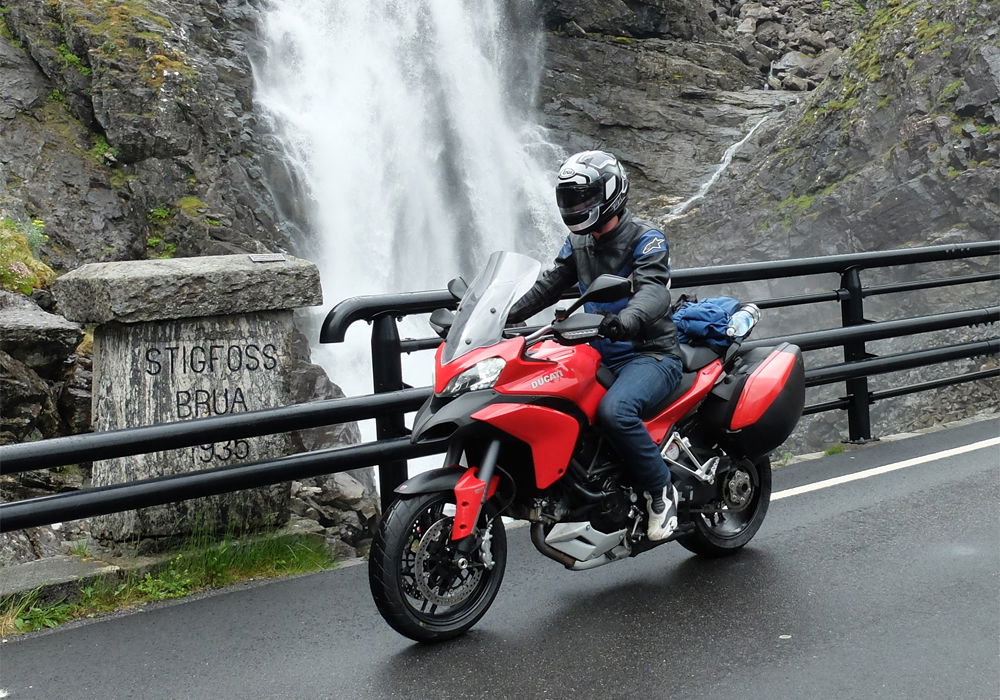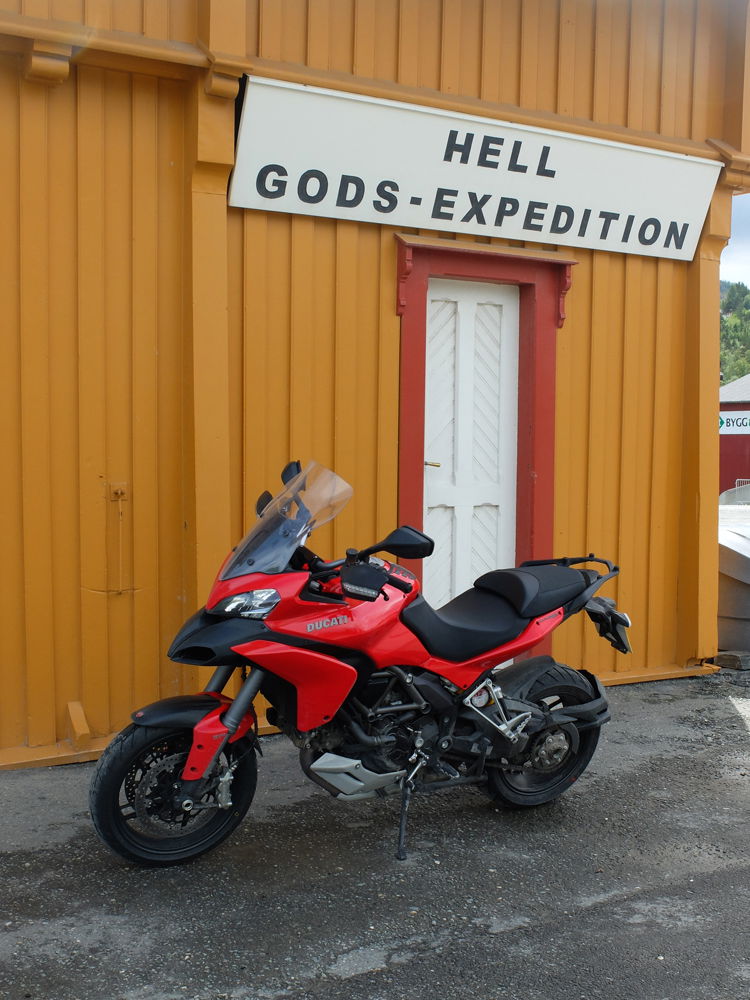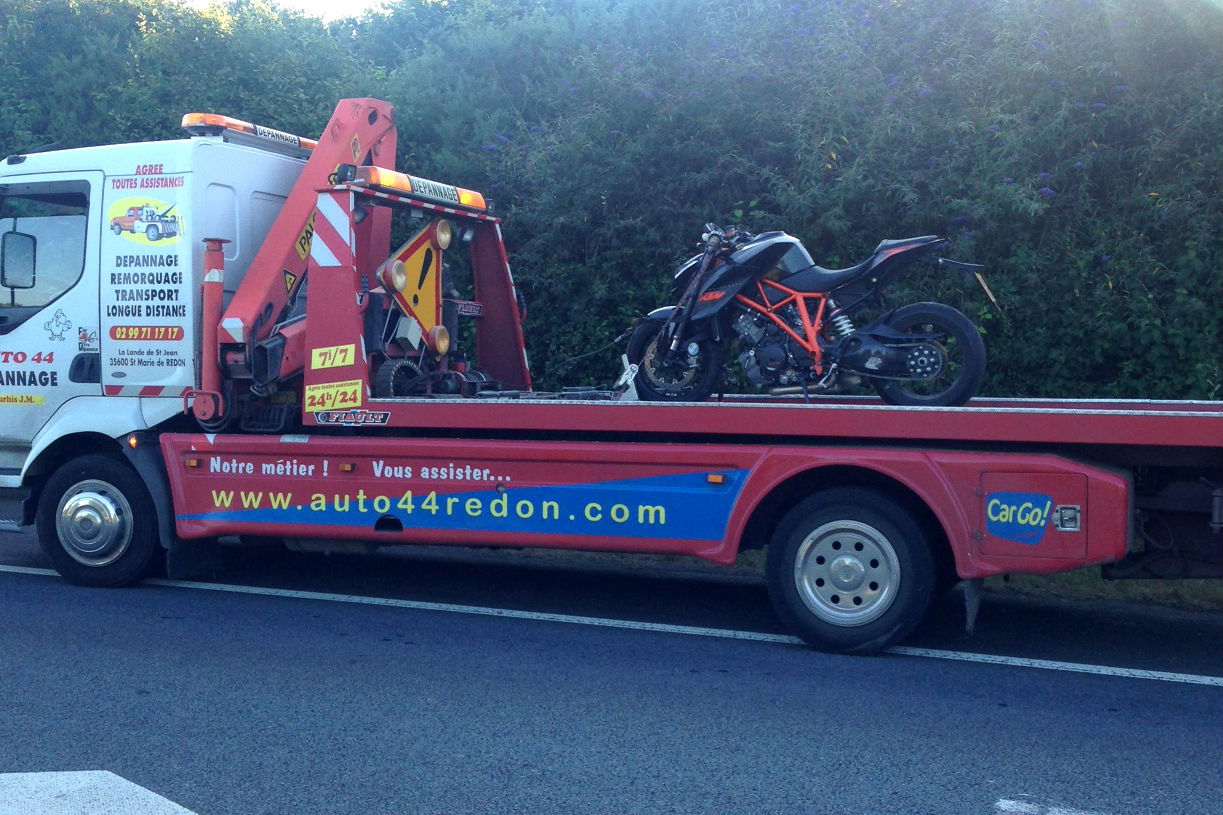Review: Ducati Multistrada MTS1200 S Touring
Tested on tour

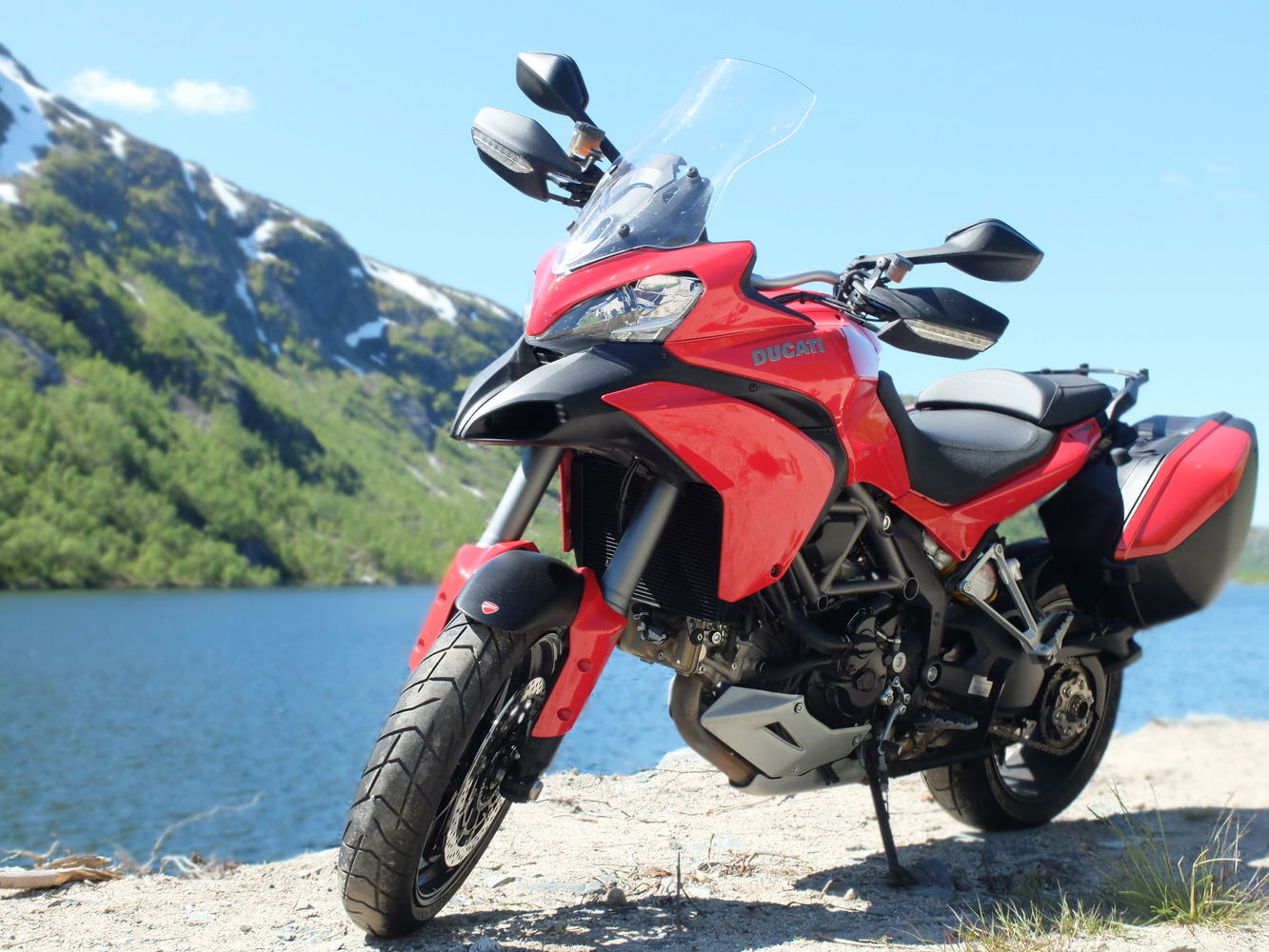
WE'VE all been there. Just about to get on your bike before a passer by stops and says “They’ve changed since my day / I used to ride you know / How fast does that go? / I’d love one but couldn’t trust myself” and so on.
The thing is, if you own a Multistrada (especially in red) you’re going to get that sort of thing happening a lot. I certainly did during the two weeks I borrowed the MTS1200 S Touring on a trip to Norway. Neighbours that have never even spoken to me suddenly wanted to know all about the bike. Sadly I was already late for a ferry so feigned deafness through my helmet before setting off.
It was just a few days later I’d swapped South London for Trollstigen, surrounded by a swarm of silver GS motorcycles. Again, it was the red Ducati that people wanted to have a look around.
But it’s no surprise the Ducati generated interest. It’s a great looking bike. And certainly one that’s hard to miss when the front lights are on. Has anyone ever pulled out in front of one of these?
The Ducati Multistrada is billed as a 4 in 1 bike, reflected by the power modes on offer.
Sport is full fat 150bhp power, with the bike always eager for you to twist the throttle more as the bike surges forward and the numbers on the digital dash rapidly rise. The 1298cc engine gets up to triple digit numbers surprisingly quickly. But perhaps that shouldn’t really be such a shock seeing as the Testastretta 11° DS engine is derived from the 1198 superbike.
The Touring mode smoothes out those 150 horses and the suspension softens everything out a bit. It’s certainly a much more relaxing way to eat up motorway miles and take in the scenery. But it’s still fast.
Urban mode cuts the power by a third. And although I couldn’t see much point in cutting the power when I first got the bike on a glorious sunny day, it turns out it’s great. I wasn’t fussed about using it at all until the end of a third consecutive day of 8 hours riding, whilst cold and soaking wet. In Urban mode the torque curve completely changes and you can get away with being really cack-handed with the throttle. Yes, that’s lazy, but after a long day in the saddle it seemed stupid not make the most of it.
It was in Urban mode that the DTC kicked in a couple of times; both when pulling out onto slippy wet junctions. I’m sure I would have been fine without the traction control kicking in but those electronics are there to assist you. And there’s no better time for that than when you’re tired and worn out.
The final mode is Enduro. This also lets you play with 100 horses but deactivates the ABS. I’d like to say I gave it a proper test off-road but after deliberately spinning up the rear on a few gravel roads and generally acting like an idiot, I thought I’d better return to the tarmac incase we both came down with gravel rash. Something pushing £16K is not something you want to end pushing yourself if it all goes wrong.
Whilst the riding modes can be customized for different levels of DTC and ABS I certainly wasn’t stretching the bike to its limits so I left well alone. Once back on familiar roads and without the panniers I would have been tempted to toy around but the base settings worked great for me.
Sport was my mode of choice, with the front wheel easily losing contact with the ground in 1st and 2nd gears when you snapped the throttle back.
Norway doesn’t have high-speed roads but it is blessed with lots of twisty ones. And the Multistrda made the most of them. I had a blast when playing about in second and third gear, powering out of corners as the bike surged forward to the next corner.
The radially mounted Brembo brakes were just as impressive as the engine and scrubbed off speed in seconds with the wide bars making it easy to turn this sporty tourer into corners before the torque engine waved them goodbye.
The riding modes were easy enough to change through when on the move as were the suspension settings which let you choose between solo riding, solo with luggage along with the same options when carrying a pillion. The electronic suspension adjustment is pretty trick and you can hear it whirring away when you as you switch the bike on. The Skyhook suspension was never challenged by the smooth Norwegian roads.
I loved the keyless ignition. As long as the keyfob is close enough to the bike you can start it up. You’ll still need the key for the petrol tank and panniers. Just don’t be tempted to keep the key in the mini-cubby box. My worst fear would be to forget they’re in there and walk away.
The dash comprises of two backlit LCDs that are really easy to read. The main one covers revs, speed, engine temp, gear and fuel level. The second smaller display shows your riding style set-up, active riding parameters, remaining fuel/distance, current fuel and average fuel consumption, average speed, air temperature and trip time. Oh, and if you’re unlucky you may get to see the ice warning show up there too.
So although that’s pretty useful stuff, all this information is reset if you swap between mph and kph. So as I went to make a note of all my vital stats after arriving back in the UK after a 2500-mile trip the computer said I had been riding for just over an hour and covered only 100 miles. D’oh.
The matching panniers look stylish, complimenting the lines of the bike. They’re also quick and easy to get on and off. The right side pannier is slightly smaller to allow room for the rear exhausts but the larger of the two can easily swallow a full-face helmet with my laptop too. To be on the safe side I made sure anything of value (and my pants) where all wrapped up in plastic bags to keep dry but I needn’t have bothered. The panniers didn’t let a drop of water in. The only snag is that while you lock the panniers to the bike, you can’t actually lock the panniers themselves so if you carrying precious cargo, you’ll have to take them with you rather than risk someone opening them up.
The screen height could’ve been a smidge bigger for me, but I am on the tall side. It was certainly easy to adjust on the move and on its lowest setting provided a cool windblast under my chin when riding that was actually very welcome on hot days, even if it wasn’t designed to work that way.
The weather can change quite quickly when you ride across mountain tops so I really appreciated the heated grips once I’d finally worked out how to switch them on (thanks James Haydon).
I did notice that with the balls of my feet on the pegs my left heel would make contact with the centre stand and push it down slightly. And a bit like a scab, once I knew it was there I couldn’t help but scratch that itch from time to time.
The hazard lights also came on occasionally when I turned left, much to the confusion of the rider behind me. For the record, the hazards are meant to flash if you hold the indicator switch left for a few seconds, but not if you just tap the switch.
Still, these are minor gripes in what is an excellent package. If you plan on touring on one of these (and you’d be a fool not to) I’d recommend you get the custom touring seat for a bit of extra comfort.
If I had the bike longer it would have been interesting to ride in the city without the panniers stopping me going for small gaps in traffic. Sadly I had to return it to Ducati’s Silverstone HQ once my trip was complete.
It’s both completely unreasonable and downright stupid to compare this bike to my own ageing SRAD, but it felt like the both engine and brakes were missing when I got back on my bike a couple of days later. The two weeks I had with the Multistrada certainly made me realise why this particular Ducati has had such success at Pikes Peak. And if Hunter S Thompson thought the 900SS was quick, I’d love to have known what he would have made of this red rocket.
The Multistrada is a genuine do-it-all machine that’ll turn heads. Still, if your wallet’s as big as your legs are long, it’ll have you grinning from ear to ear. For those making the move from sports bikes to tourers, this is certainly fast enough to keep you entertained. I’m not surprised Visordown readers voted the Multistrada so highly.
Read the Visordown 2013 Ducati Multistrada MTS1200 S Touring first ride review.
Ducati Multistrada 1200 S
Price: £15,795 (ABS)
Top speed: 150mph
Engine: 1198cc liquid-cooled, 8-valve L-twin
Power: 150bhp @ 9,250rpm
Torque: 91.8 lb-ft @ 7,500rpm
Front suspension: 48mm fully adjustable USD forks. Electronic compression & rebound damping adjustment with Ducati Skyhook Suspension
Rear suspension: Electronic compression & rebound damping adjustment. Electronic spring pre-load adjustment with DSS Aluminium single-sided swingarm.
Front brakes: 2 x 320mm discs, four piston radially mounted Brembo calipers
Rear brake: Single 245mm disc, two piston caliper
Dry weight: 206kg (claimed)
Seat height: 850mm
Fuel capacity: 20 litres
Colours: Red, Matt Chrome

